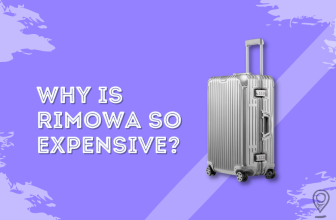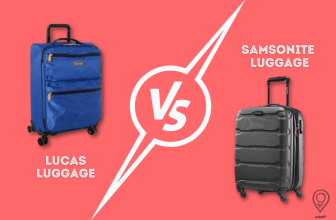
A backpack is more than just leather and cloth sewn together. It comes in different types and features like diaper backpacks to smell-proof backpacks, backpacks with lots of pockets, and so on. They are crucial components of our daily lives. Many people use them, from students to hikers lugging them into the wilderness. And to do backpacking is a workout on its own. It’s tough on the body to carry a huge pack and climb mountains.
The weight of the backpack will impact the experience of your trip. It can make your travel more comfortable if it is lightweight, and if it is hefty, it adds trouble to your journey. Finding the ideal balance between comfort and weight is, therefore, essential. So how do you determine the importance of a backpack? There are various factors to consider when deciding how much your bag should weigh.
What’s the Weight of an Empty Backpack?

The weight of an empty backpack ranges between 1-6 lbs. While most hiking backpacks weigh between 3-6 lbs., ultralight backpacks weigh just 1-2 lbs. The design, materials and recommended maximum load determine the bag’s weight.
If we wish to categorize the weight of backpacks, it has the main types of packs, and each has a distinct weight when empty.
Rucksacks Or Backpacks for Multi-Day Hikes
A multi-day hike knapsack has different weights. A rucksack weighs between 2 and 4 pounds. But Most lightweight packs fall into the 3-to-3.5-pound category. Additionally, there is a substantial variation in the empty weight of backpacks from different manufacturers, designs, and materials.
For instance, the Kelty Trekker 65 weighs 5 pounds 13 ounces, whereas the Osprey Atmos 65 weighs only 3 pounds 9 ounces.
Daypacks Or Backpacks for a Day Trip
Generally, Bigger daypacks weigh more when empty. A typical standard-size daypack weighs less than 4.4 pounds. A 50-liter Osprey Kode 22 and an 80-liter Osprey Aether AG 85, respectively, each weigh 2.9 and 3.9 pounds.
Typically, a smaller daysack weighs less than 2 pounds. For instance, a 35-liter Osprey Viper 9 weighs 0.8 kg, 1 lb 12 oz, and a 25-liter Osprey Skarab weighs 1 lb 15 oz.
Running Vests Or Backpacks For Running Trails
Smaller running vests weigh less than heavier ones. The smallest hydration pack is the CamelBak, which weighs 12 ounces, while the heaviest can weigh up to 33 ounces. A backpack or jacket is lighter without a water reservoir. A CamelBak weighs about 2 pounds when it includes its reservoir, but it only weighs about 14 ounces when it does not.
How much should your Backpack Weigh?

Many factors affect how much your bag should weigh. Due to this, it becomes difficult to estimate the exact backpack weight. So, pick a backpack that is soft on your back and spacious enough to carry everything you need. One that is manageable and accessible is what you want.
Most outdoor experts agree that an average adult male or female shouldn’t carry more than 25% of their body weight at one time when hiking or camping. It would help to consider a few factors when deciding how much weight you should carry in your backpack.
Your Backpack’s Weight
The weight of the backpack is the most critical factor, which directly depends on the importance of the goods it carries. When you have more weight, it puts more strain on your body and back. So, to avoid carrying unnecessary weight, take your time to weigh everything you pack. Try to swap heavy weigh goods with alternates ones like books are more serious than maps or gadgets.
Trip Duration
The weight of your backpack will be significantly influenced by how much time you expect to spend on the trip. If you’re only planning a weekend trip, bring less luggage than if going on a long extended period. For instance, you generally will get fewer luxuries than you if you go on a thru-hike. Instead, you will concentrate more on having the necessities with you.
Journey’s Topography
How much weight you carry in the backpack depends on the terrain you’ll be hiking through. Consider a trip where the elevation will vary significantly at several points along the way. If so, you should bring less gear than if you were going on a journey that would be mostly level. Climbing hills and mountains require more physical effort than moving on flat terrain.
Individual Preference
Your personal preference is one of the essential aspects to consider when deciding how much weight to carry within your backpack. One advantage is that it lets you alter your product to suit your needs better. You are not compelled to abide by any rules; instead, you should concentrate on doing what would benefit you the greatest.
What is Backpack Weight Distribution?

Backpack weight distribution organizes the bag’s contents in a way that will feel comfortable to your body. If you manage your backpack, you’ll save time taking out your pack, setting up camp, and then shabbily putting it back inside.
- Put large soft items like a sleeping bag, travel pillow, sleeping pad, hoodie, or tent on the bottom of the backpack.
- Place oversized firm items like food, a cooking set, and a bear bottle you don’t frequently require in the middle of the bag.
- Stack things you frequently use on top, like hunting knives, outerwear, jackets, travel humidor, toilet paper, maps, water bottles, etc.
- If possible, avoid hanging items on the backpack.
Signs: If your backpack is too heavy
- It hurts when you wear it.
- It’s challenging to take on or remove the bag.
- Your limbs start to tingle or go numb.
- You can see strap traces on your shoulders.
- If you wear it, your posture will change.
Tips To Reduce the Weight of the Backpack

backpackers know the benefits of carrying less gear. You can go farther, faster, and in comfort. Use these ways to shed some extra pounds from your backpack.
Know Your Base Weight
Calculating your base weight is essential before packing for a trip. It consists of everything you are carrying except food and water. Just be sure to take an honest assessment of everything in your luggage since, when it comes to reducing weight, even the most minor items can add up.
Weigh Your Gear
To weigh everything, remove it from the pack and weigh the bag with a kitchen scale. Then swap it out for lighter versions of your equipment. It should be simple; remember that you undoubtedly have many items inside that you no longer require!
Use Multipurpose Gear
To do light packing, choose gear that is designed with dual-purpose features. For instance, a cooking pot that serves as both a plate and a bowl weighs less than one that is only a pot.
Plan Meals Wisely
plan each meal, from breakfast to dinner, and examine what you have in the pack, how many calories you need to take, and how far away you’re next to restock. You may travel further while carrying less weight if you eat correctly.
Conclusion
Now you know how much backpacks weigh and what intelligent techniques are to reduce your backpack weight. It is difficult to determine the exact weight of your pack because it depends on various things. This is so that you can consider other factors, such as your physical condition and stamina.
When buying a durable backpack, we recommend north face backpacks and suggest methods to wash them.







